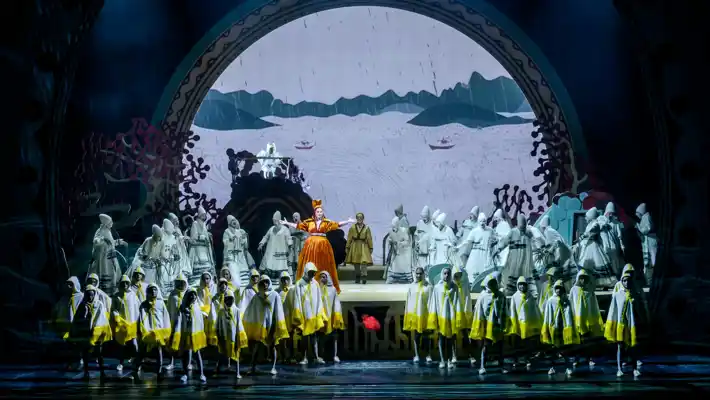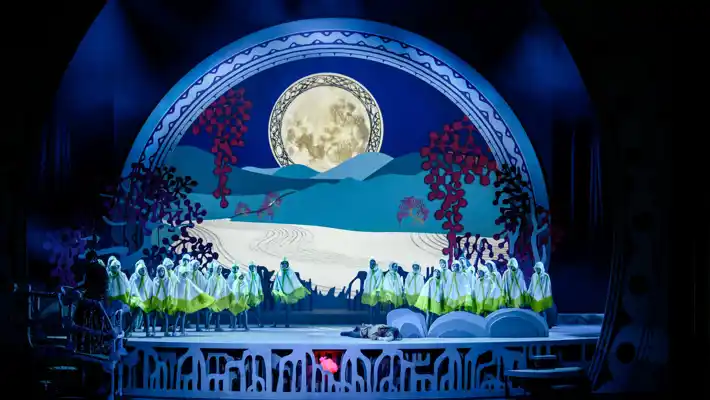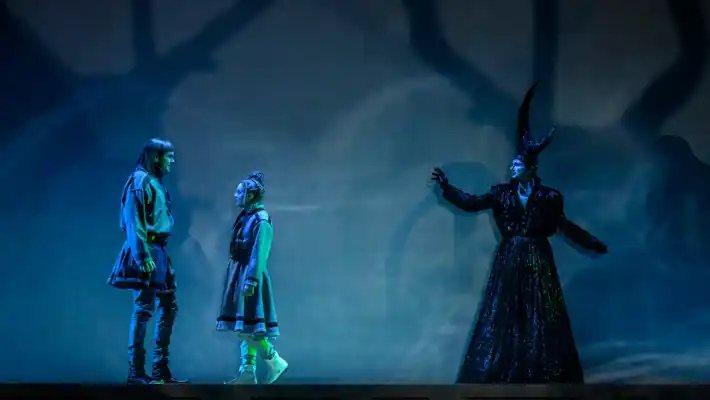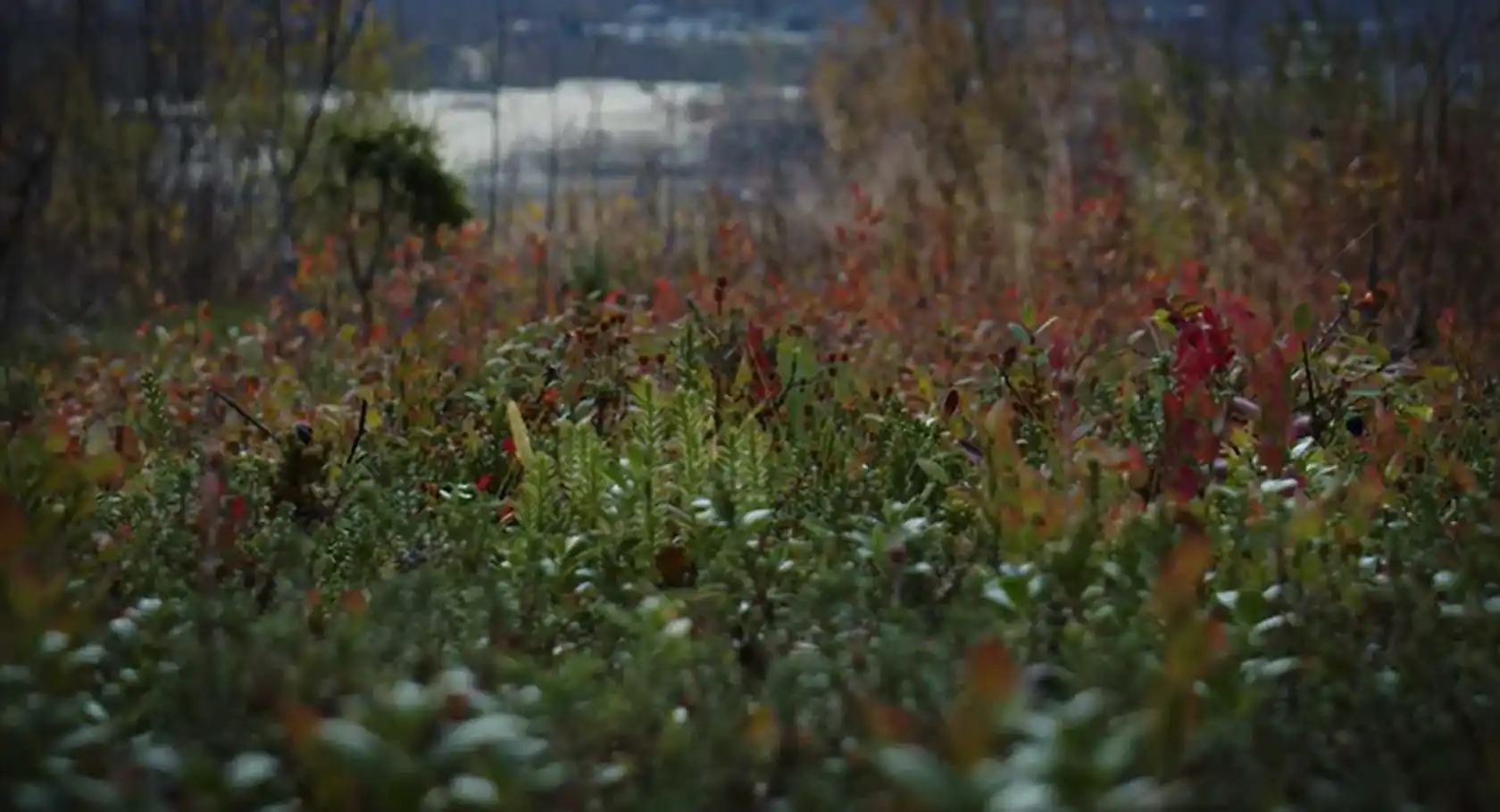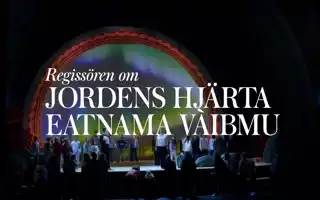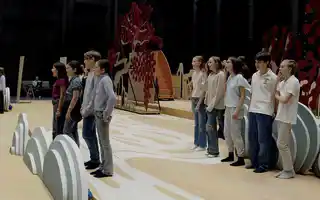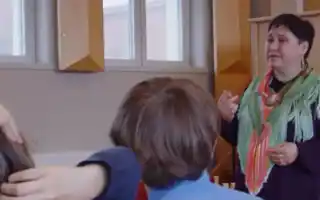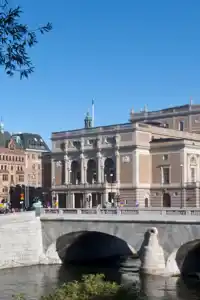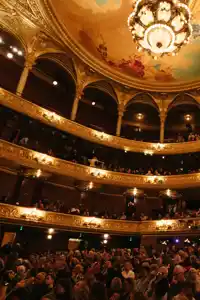Eatnama váibmu
A tale about the beginning of everything

-
DATES:Nov 15 — Dec 29
-
STAGE:Main stage
-
RUNNING TIME:Approx. 1 hr 15 mins
-
LANGUAGE:Northern Sami, Swedish sutitles
The family performance of the year! The opera Eatnama váibmu (The Heart of the Earth) takes us on a fairytale journey in the Sami tradition.
The Heart of the Earth, Eatnama váibmu, is a colorful musical experience with Sami origins about the mysticism and the struggle between good and evil. With rhythmic drum beats and elements of joik, the story is told in Northern Sami about the beating heart of the earth. The performance is for all ages, you get the best experience if you can follow along with the text on the text machine (in Swedish)!
Matinee performances
On weekends we run double performances. Choose November 29, December 14 or 27 and in step two you can choose between a performance at 3.00 p.m. or 5.30 p.m..
-
One act
Performance dates
Synopsis, characters, interviews with the conductors & teacher's guide
-
Synopsis
Ipmil (the Creator) wanders alongside the primordial sea, where Jámešgázzi – restless spirits and ghosts – make noise between the worlds. Ipmil orders them to be silent, but they do not obey. Ipmil is furious, and decides to create a new, peaceful world – a place that is free from noisy spirits.
Ipmil summons their children Beaivi (the Sun) and Mánnu (the Moon). Beaivi promises to shine over the new world, but Mánnu is doubtful. Ipmil summons their reindeer from the sacred mountain Bassivárri, sacrifices her and shapes her body into the new earth. Her flesh becomes land, her blood becomes rivers, her fur becomes forests, her skull becomes the heavens and her eyes become stars. A bone is thrown to the spirits, who immediately begin to build a bridge from the bone, between the underworld and the new world.
Ipmil then creates two humans – the brothers Háhčes and Njáveš – who are sent down into the world through the rays of the sun. Beaivi watches over Ipmil’s creation, while Mánnu is given the kingdom of the shadows. Ipmil hides the reindeer’s heart in the depths of the earth, where it begins to beat. Njáveš hears the heartbeat, but Háhčes can’t hear it.
The new world is plentiful: meat grows on the trees, cream flows in the springs and the rivers are teeming with fish. The brothers live in great joy, but Háhčes soon grows restless – the world is too quiet. Amid the dusk he meets Mánnu, who lures him to the realm of the shadows beyond the bridge. Háhčes follows him.
Njáveš wakes up to find his brother gone. He laments his loneliness and Beaivi, moved by his tears, smiles and sheds a tear himself. From Beaivi’s tear, Beaivvinieida – the Sun Daughter – is born. She enters the world and brings with her the joik, the traditional chanting song of the Sámi people. By joiking, she attracts a reindeer calf. Njáveš and Beaivvinieida fall in love with each other. Both can hear the heartbeat of the earth, and they become a couple.
In the realm of the shadows, Háhčes feels lost. Mánnu explains that Njáveš has found a new life partner and no longer needs him. These words fill Háhčes with despair. Mánnu tries to sow hatred in him, but Háhčes resists. Then Mánnu summons his daughter Mánunieida from the world of the winter night. She comes reluctantly, angry and suspicious, but Háhčes falls in love with her. When he tells her about the world of light, filled with abundance, she wants to follow him there. Together, they cross the bridge to the light.
Njáveš welcomes his brother joyfully, and they are reconciled. Beaivvinieida greets Mánunieida with friendliness and hospitality, but Mánunieida feels alienated from it all. When Beaivvinieida and Njáveš listen to the heartbeat of the earth, Mánunieida is filled with suspicion because she cannot hear it. Njáveš builds a hut for his brother, but Mánunieida immediately sees that it is smaller than his own. Despite her dissatisfaction, she moves in.
Time passes, and both women have children. When a herd of reindeer runs past, Beaivvinieida joiks and the reindeer gather around her. Mánunieida also tries to joik, but her harsh voice frightens the reindeer. She only manages to catch one calf with a lasso, and when the men laugh at her she bursts into anger.
The furious Mánunieida accuses Háhčes of being useless, and says that she would be better off without him. The restless spirits stir up the quarrel until Njáveš intervenes. The brothers fight, and Háhčes kills his brother. Beaivvinieida finds Njáveš dead and mourns deeply. Háhčes is devastated, but Mánunieida whispers that Njáveš got what he deserved. Njáveš’s soul passes to the realm of the dead, where Ipmil awaits.
Ipmil is furious that blood has been spilled on the earth, and is angry at the greed, hatred and evil of humans. When the Jámešgázzi force their way in, Ipmil decides to reset the world once more: the sea will rise up and drown everything. Ipmil curses Mánnu and attaches Háhčes to the moon as an everlasting sign of his betrayal.
A violent storm breaks out. Beaivvinieida saves Mánunieida and both of their children, and begs Ipmil for mercy. Moved by her compassion, Ipmil allows them all to live – but from now on, humans must struggle if they are to find the good. Still, there is hope – as long as they listen to the heart of the earth. -
Characters
IPMIL (The Creator)
A dual being who embodies both Ráđien áhčči (the Heavenly Father) and Mattar-áhkka (the Primordial Mother) — the one who gives birth to and shapes worlds.
BEAIVI (The Sun) – children’s chorus
Created by Ipmil. A life-giver who spreads light and warmth, entrusted with watching over the new world.
MÁNNU (The Moon)
Also created by Ipmil. Feels overlooked and jealous of Beaivi — a trickster assigned to guard the realm of darkness and shadows.
NJÁVEŠ (The Sun’s Son)
One of the two brothers created by Ipmil for the new world. Lighthearted, sociable, and cheerful, though somewhat vain and inattentive. He can hear the sound of the earth’s heart.
HÁHČES (The Sun’s Other Son)
Njáveš’s brother. Curious and dreamy, yet often restless and uncertain. Drawn to the unexplored darkness — and unable to hear the earth’s heart.In pre-Christian Sámi mythology, humankind was created when Ipmil sent the soul down to the new world through the sun’s rays — through all four directions. That is why human beings are called the Children of the Sun.
In Sámi, there is no gendered pronoun (he/she), only a neutral word — son — for people.
BEAIVINIEIDA (The Sun’s Daughter)
Born from Beaivi’s tear — a tear of laughter and compassion. Lush, patient, and warm-hearted, she is Njáveš’s life companion. She brings joik (the traditional Sámi song form) into the world and can summon the reindeer with her singing. She can hear the heartbeat of the earth.
MÁNUNIEIDA (The Moon’s Daughter)
Created by Mánnu, called forth from the darkness to be married to Háhčes. In her eyes shine the stars of the winter night; she carries the powers of the northern lights and frost.
Impatient and hot-tempered, always searching and dissatisfied, she never truly finds her place in the world of light. She cannot hear the heart of the earth.
THE REINDEER CALVES
Performed by the children’s chorus. One calf becomes Beaivinieida’s faithful companion; another is captured by Mánunieida but manages to escape.
JÁMEŠGÁZZI (The Restless Spirits)
Souls of the dead who are trapped between worlds, unable to cross into the realm of the departed. They are anxious and homeless, drawn to human conflict where they stir up unrest and confusion. -
Interviews with the conductors
It’s not every day that a newly written opera is staged on the Royal Swedish Opera’s main stage. The responsibility for conducting the orchestra, chorus, and soloists is shared between Anna-Maria Helsing and David Björkman.
Hello Anna-Maria Helsing! By now, you’ve become very familiar with the score of Eatnama váibmu/The Heart of the Earth. How would you describe the character of the music in this work?
- Eatnama váibmu is a wonderful opera because the music truly goes hand in hand with what happens on stage. It paints the full range of emotions—from wild fury and dangerous situations (the percussion outbursts in Háhče’s and Njáveš’s fight, or Ipmil’s rage at his deceitful creation) to deep, almost wordless sorrow (the stripped-down music after Njáveš’s death). The piece contains many different musical characters, but overall I’d say Byström’s music feels immediate and natural, yet full of subtle wit. Rhythm is a strong element—different time signatures often play against each other, and there are many folk-inspired touches, such as the use of joik. The music is rich in color: the strings make abundant use of harmonics and pizzicatos, which in several passages give the music a light and delicate quality. The choruses have an important role in the opera, and in the orchestra we find some unusual instruments—such as the musical saw and specially made percussion instruments crafted from reindeer hooves!
What was your relationship to Britta Byström’s music before taking on Eatnama váibmu?
- I’d listened to some of Byström’s music before, but prior to this opera I had only conducted one of her orchestral works—Segelnde Stadt from 2014. We performed it with the Norrköping Symphony Orchestra eight years ago, and I remember being impressed by how elegant and well-crafted it was. Byström has a tonal foundation combined with a strong sense of color and transparency—she’s a sensitive and skillful orchestrator.
Is there a particular passage in Eatnama váibmu that you’re especially fond of?
- It’s hard to pick just one, but I’m very fond of Byström’s writing for the children’s chorus. It sounds absolutely beautiful and represents much of the light and hope in the piece. The percussion also plays a key role, and I really enjoy the moments when they’re allowed to unleash their energy. Mánunieida’s music is often quite demanding—she’s constantly furious and irritated, which requires a fast tempo and some tricky rhythms. The women’s chorus also has challenging music, where the restlessness of the lost spirits is expressed through insistent, relentless rhythms and accelerating tempo. The ending is among the most beautiful moments in the opera: the children’s chorus, the women’s chorus, and several soloists come together in a radiant, peaceful final chorale that leaves you with a sense of hope for the future.Hello David Björkman! By now, you too have become very familiar with the score of Eatnama váibmu/The Heart of the Earth. How would you describe the character of the music in this work?
- Yes, exactly—by now the work feels like its own personality! It’s a wonderful moment when you can relate to a piece as a living being. And like all personalities, it has many layers. Byström has created a multifaceted score that at times gives us the rattling and jingling of a vast reindeer herd, and at other times shifts to a majestic, grand narrative when the creator Ipmil steps forward. The children’s chorus is also an important part, bringing a sense of light and natural purity throughout. Overall, I’d describe the music’s character as otherworldly.
What was your relationship to Britta Byström’s music before taking on Eatnama váibmu?
- I had encountered her music a few times before—first during my conducting studies, when she herself was still a fairly new composer. Later, I had the pleasure of conducting one of her trumpet concertos, with the Royal Swedish Orchestra’s principal trumpeter Tora Thorslund as soloist. I find Britta’s compositional style inviting, well-considered, and full of craftsmanship—rhythmically driven, yet lyrical and challenging. That makes it a joyful task to bring this story to life through her musical language.
Is there a particular passage in Eatnama váibmu/The Heart of the Earth that you’re especially fond of?
- When there are rhythmically playful and slightly complex passages, that’s when my brain feels its happiest! The Moon Daughter’s (Mánunieida’s) part contains many over-dramatic moments with a flurry of percussion beneath, combined with numerous tempo changes and rhythmic modulations—which is always fun. But perhaps my favorite moments are the simple, heartfelt songs, some of them based on joik, which sound truly genuine and in harmony with the Sámi narrative. I really think Britta Byström has given us a beautiful and generous musical fairytale.
Nicholas Ringskog Ferrada-Noli
Editor, Royal Swedish Opera -
Teacher's guide
Are you visiting the show with a school class? Download our teacher's guide (in Swedish) to Eatnama váibmu/The Heart of the Earth: familiarize yourself with the show before your visit or delve into the experience afterwards.
Introductions & talks
In connection with the world premiere on November 15, all ticket holders are welcome to a free talk in the Golden Foyer at 6 p.m. where dramaturge Katarina Aronsson meets composer Britta Byströmton, librettist Rawdna Carita Eira, director Elle Márjá Eira, scenographer Markus Granqvist, costume designer Lena Lindgren and choreographer Joakim Stephenson who present their thoughts on Eatnama váibmu.
On other performance days, a free introduction to the piece takes place in the Golden Foyer 45 minutes before the performance starts!
-
Cast
-
-
Music & creative team
Music Britta Byström
Libretto Rawdna Carita Eira
Conductors Anna-Maria Helsing/David Björkman
Director Elle Márjá Eira
Scenography and light Markus Granqvist
Costumes and make-up Lena Lindgren
Dramaturge Katarina Aronsson
Translation Anna Linden
Choreography Joakim Stephenson
Cast subject to change.
Your visit to the Opera
Frequesntly asked questions
-
At what time do I have to be at the Opera before the performance?
We recommend that you arrive at least half an hour before the performance begins. If you can arrive earlier, it's even better: 45 minutes before the start of the performance, there is a free audience introduction in the Golden Foyer - an excellent way to approach the performance! Please note that once the performance has started, no one will be allowed into the hall until after the first intermission.
-
It's my first time at the Opera - what do I do?
We have put together some useful tips for your visit. Otherwise, our best advice is to arrive on time - discover the Opera House, leave your coat in the cloakroom, eat or drink something. AND, ask our ushers - they'll be happy to help! Outerwear and bags should be left in the cloakroom for safety and evacuation reasons.
-
Can my ticket be rebooked or cancelled if I or someone in my party is ill?
You can rebook tickets yourself on the website up to 24 hours before the start of the performance within the the current season. Tickets cannot be cancelled (read more in our general terms and conditions).
-
Can you eat and drink at the Opera?
Of course you can! Our partner Restaurang Grodan is on the ground floor facing Strömgatan - take the opportunity to book a table ahead of your visit! Each floor also has a service with drinks and snacks, at the stalls' café there is a slightly larger selection. We advice you to pre-book the intermission service so it is ready and waiting for you during the interval!
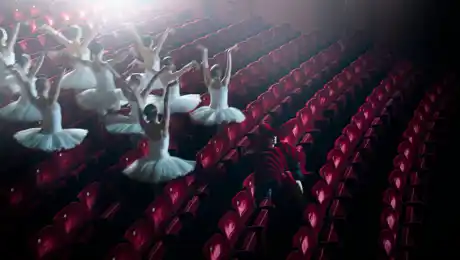
Don't miss a single beat!
Did you know that our newsletter subscribers always get the latest information first? Stay up to date on upcoming productions, ticket releases and other news.
Subscribe to our newsletter →